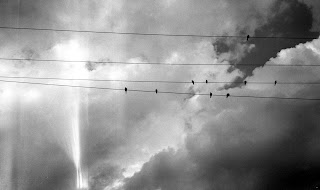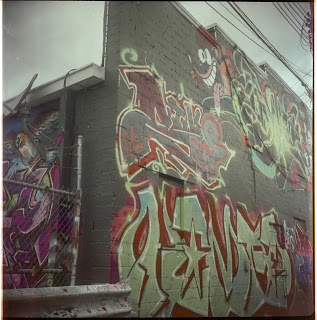Saturday, July 8, 2023
Olympus Infinity Stylus Epic
Saturday, March 4, 2023
Film Negatives - Flat or Curl
 |
| Flat Negatives Are Your Friends |
Photographic film negative curling is an issue if you develop film yourself. During the digitizing or printing workflow your negatives will need to be scanned, photographed or used in a darkroom enlarger. Having film negatives "flat" is important. Even the slightest curling / cupping of the negative can make the film difficult to put into a scanner holder, keep flat on the scanner glass or keeping the entire photo in focus. You WANT your negatives to be as flat as possible for good results.
Different film stocks "curl" / "cup" to various amounts or remain flat while drying. How you dry your negatives (i.e., hanging with a weighted clip on the bottom) or your drying conditions (i.e., humidity level) will also impact how much a negative does or does not dry flat.
Here are a couple examples of flat and slightly curled negatives. Your results may be similar or much more cupping / curling.
 |
| Fomapan 400 dries flat |
 |
| Fujicolor Superia X-TRA 400 has a moderate curl. This negative has been back-rolled |
There are DIY ways to flatten curled negatives. You can cut your negatives, sleeve them and put them under a weight (like a book). You can back-roll the negative before cutting and keep it back-rolled for a few hours until flat, etc.
Again, what ever process you use, the simplest is to use film (WHEN POSSIBLE) that dries flat.
To help you decide, here is a list of films I've (or others) have used and how they "typically" end up when dried. Please note, this list covers just 35mm film. 120 film curls more or less the same but if it curls it tends to curl more than 35mm. AGAIN AS A CAVEAT, your experience may vary.
- ADOX HR50 - flat
- Agfa APX 100 - flat
- Agfa APX 400 - slight curl
- Arista 100 / 200 / 400 - flat
- Berger Pancro 400 - slight curl
- Camera Film Photo (CFP) 500T The Film - flat
- CFP Kiki Pan 320 - flat
- CineStill BWXX - slight curl
- Dubblefilm Jelly - flat
- Eastman Double-X (5222) - flat
- EFKE 100 - curls
- Fomapan 100 - flat
- Fomapan 200 - flat
- Fomapan 400 - flat
- FPP Mummy - flat
- FPP RetroChrome 320 - curls
- Fujicolor Pro400H - light curl
- Fujifilm Provia 100 - curls
- Fujifilm 200 - slight curl
- Fujifilm Fujicolor Superia X-TRA 400 - curls
- Fujifilm Fujicolor Superia 800 - flat
- Holga 400 - flat
- Ilford Delta 100 - flat
- Ilford Delta 400 - flat
- Ilford FP4 - flat
- Ilford HP5 - flat
- Ilford Ortho 80 - flat
- Ilford PAN 400 - flat
- Ilford SPX 200 - flat
- Ilford XP2 400 - flat
- JCH Streetpan 400 - flat
- Kentmere 400 - flat
- Kodak Ektar 100 - flat
- Kodak Ektachrome 100 - flat
- Kodak EliteChrome 100 - curls
- Kodak EliteChrome 200 - curls
- Kodak Gold 200 120 - curls
- Kodak Kodalith 6556 - flat
- Kodak MAX 400 - curls
- Kodak Plus X 125 - slight curl
- Kodak Portra 160/400 - flat
- Kodak Portra 800 - flat
- Kodak T-Max - flat / slight curl
- Kodak T-Max 3200 - flat / slight curl
- Kodak Tri-X - curls
- Kodak Ultramax 400 - flat
- Kodak Vision3 250D - flat
- Kodak Vision3 500T - flat
- Kodak X-Pan 125 - slight curl / flat
- Kono Moonstruck - flat
- Kosmo Foto Agent Shadow - slight curl
- LuckyPan 400 = flat
- ORWO UN54 - flat
- Rollei Retro 80s - flat
- Rollei Retro 400s - flat
- Rollei RPX25 - flat
- SHD100 Pro = flat
- Shanghai GP3 - curls
- Street Candy 400 - slight curl
- Silberra Ultima - flat
- Ultrafine 100 - flat
- Ultrafine Finesse 400 - flat
Wednesday, January 18, 2023
Leica M6
I purchased a Leica M6 Classic 35mm film camera approximately a year ago. It's the camera I've lusted for years, but finally had the opportunity to buy one. It is my current favorite film camera even though it's not the most advance, it's almost completely manual, and honestly it doesn't take the best photos if compared to my more advanced SLR's.
However, the M6 fits my film photography style perfectly.
There are many blogs posts, articles and write-ups that discuss the specs so I won't go into technical details. If you want a deep dive I'd recommend the following article by Emulsive.
My Leica is an M6 Schwarz Classic. It was "crafted" in 1991. It's all black sporting the classic Leica red dot logo. I purchased it with a Summicron-M f/1.2 35mm lens. The lens was made in 2000. This is a perfect film street photography kit IMHO. This is what I primarily use it for, although it's also a perfect setup for landscape photography. I also recently purchased a Canon Serenar f/1.8 LTM 50mm (with an adapter) as my 50mm option.
I first saw the camera about 1 1/2 years ago at a camera swap / meetup hosted by a local fashion magazine / studio. I had a table selling some excess studio equipment. A gentleman (who was not a photographer) had a table across from me selling about 6 camera travel cases full of high end camera equipment. He was entrusted to sell the equipment on behalf of his uncle's estate. Amongst the equipment was the Leica.
He was selling the M6 with the Summicron lens and asking between $5,000-6,000. He had done his homework on prices, but not on the working condition or marketability of the equipment he brought. I could tell the Leica had good bones, had been well used but not abused. However, it clearly hadn't been used in some time. It looked rough.
 |
| The camera when I first saw it. The photo actually makes it look better than it actually was in person |
The gentleman let me look it over and test it out. I could tell the shutter speeds were off, the leather was coming loose in several places, the viewfinder was fogged and the film advance action was very stiff. I told him thanks, but it was out of my budget.
Throughout the meetup I thought a few times I should buy it. However, I was serious about my budget so I just went about my business. There were several people who ogled, handled and negotiated for it, but no serious buyers. By the end of the meetup the Leica M6 hadn't sold so he came over and asked about my budget. I said $3,500. I thought he would just laugh, but he didn't. He said he would think about the price, try to shop it around, take it to a few camera stores. If it didn't sell he would get back with me. I gave him my contact information, but didn't expect a followup.
About 3 months went by and I didn't hear anything. I forgot about it. Then to my surprise he contacted me. He had taken it in to a local camera store for grading and gauge their interest. The store recommended sending it to Leica for repairs and a CLA. They offered what I suspected was a somewhat low price (market less their risk adjusted sales / inventory commission). He told me if I would split the cost of repairs he would sell it to me for my $3,500 offer (body plus Summicron lens).
I told him he had a deal and we shook on it. It came back from Leica about 2 1/2 months later and my share of the repairs was $350. Leica replaced the leather, adjusted and cleaned the viewfinder, replace the light seals, adjusted the light meter, adjusted the shutter speeds, adjusted the speed dial, and CLA'd it. Wow!
I had my M6 for $3,850!! I think this is was a very fair deal and he said he was super happy it was in the hands of someone who would use it versus simply resell it.
I've put approximately 20-25 rolls of assorted film through the M6 so far. I've used it for street photography trips to NYC, Cincinnati, Chicago, and my home town of Indianapolis. I also took it with me this past October during a hiking vacation in the Colorado Rocky Mountain National Park. It's almost always in my camera bag. It's been superb. Easy to use, reliable and consistent quality.
As mentioned I'm not going into spec details, but it does have 1) an easy to use TTL arrow based light meter easily visible through the viewfinder, 2) ISO range from 6 - 6400, 3) shutter speeds from B - 1/1000, 4) works without batteries (simply use sunny 16 or external light meter, & 5) a hotshoe.
As a side note, the Leica M6 has a loyal following and a large demand so Leica recently re-released the M6 with only moderate upgrades. The M6 is available again! The new Leica M6 is essentially the same camera as mine which as of this writing is 32 years old.
Here are some photos with different film stocks / lighting conditions / locations:
 |
| Fomapan 400 - Indianapolis |
 |
| Fomapan 400 - Indianapolis |
 |
| Fomapan 400 - Central Indiana Farmland |
 |
| Fomapan 400 - Central Indiana Farmland |
 |
| Fujicolor 200 - Rocky Mountain National Park |
 |
| Fujicolor 200 - Rocky Mountain National Park |
 |
| KiKi Pan 320 - Indianapolis |
 |
| KiKi Pan 320 - Indianapolis |
 |
| Fomapan 400 - New York City |
 |
| Fomapan 400 - New York City |
 |
| Fomapan 400 - New York City |
 |
| Fomapan 400 - New York City |
 |
| Fomapan 400 - New York City |
 |
| Kodak Vision3 250D - Broad Ripple |
 |
| Kodak Vision3 250D - Broad Ripple |
 |
| Kodak Vision3 250D - Indianapolis |
Bottomline, the Leica is a VERY well build, high end film camera well suited for street photography, general snapshots and landscape photography IMHO. The price (both used and the new version) puts it out of reach of most photographers so it's still a niche camera. However, I'm VERY happy I was able to get one!
Thursday, January 12, 2023
Kodak Duaflex II with Rerolled 620 Film
- 72mm f/8 lens
- Range focusing
- Aperture set with a slider under the taking lens at: f/8, f/11 & f/16
- Cash shoot with B mode via a sliding switch under the shutter release


















